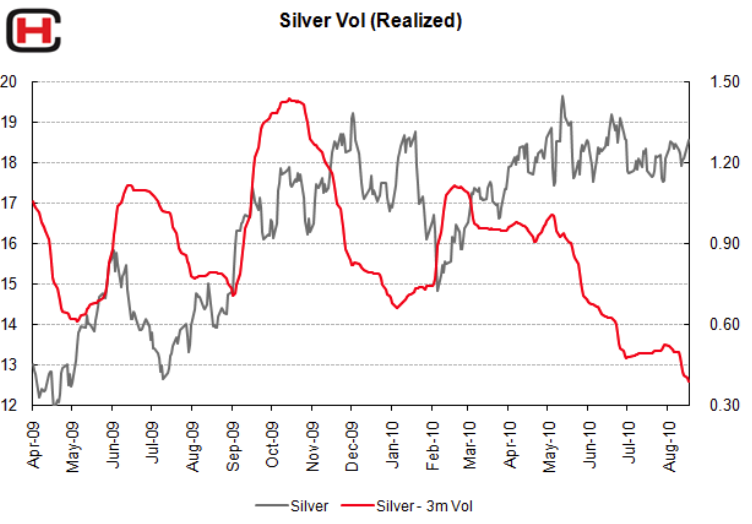
Money can lose its value through excessive abundance, if so much silver is coined as to heighten people’s demand for silver bullion. For in this way the coinage’s estimation vanishes when it cannot buy as much silver as the money itself contains…The solution is to mint no more coinage until it recovers its par value – Copernicus
Silver Velocity to rise
Our Hinde Silver Trend model has reached a significant low that usually precedes a dynamic move. This move can be lower or higher but our other technical indicators signal a move higher is the most likely scenario.

Silver Seasonality
Our silver seasonality analysis suggests that the trend will be directionally higher in price.

Silver Volatility
Other than just purchasing silver bullion (in allocated form), speculators could purchase volatility. As one can see from the chart below historical price volatility is at the lowest standard deviation on a rolling 3 month basis that it has been for sometime. Straddle break evens look attractive or likewise out-the-money call premiums look cheap, for those who agree with our directional bias for a move higher.

Silver’s timeless fascination
Mankind’s timeless fascination with silver stretches back millennia. As early as 700 B.C., the Mesopotamian merchants used silver as a form of exchange. Later, many other civilizations also came to recognize the inherent value of silver as a trading metal.
The ancient Greeks minted the drachma, which contained 1/8th ounce of silver; and in Rome, the basic coin was the denarius, weighing 1/7th ounce. And let’s not forget the English shilling “sterling,” originally denoting a specific weight of silver, which has come to mean excellence. In fact the words for “silver” and “money” are the same in at least 14 languages.
Silver or money is derived from the Ancient Greek: ργήντος – argēntos, gen. of ργήεις – argēeis, “white, shining” ). The Incas of Peru called it the “tears of the moon” because they were awed by silver’s strange gleam and the Chinese believed that a silver locket hung around a child’s neck would ward off evil spirits.
In recent years silver has grown to be regarded as the poor man’s gold. However we suspect silver will shake off this unfortunate shackle and give gold a “run for its money” as the old idiom goes.
There are key fundamental differences between gold and his poor cousin silver. Demand for gold is almost entirely from those holding for financial safety and protection of purchasing power and likewise from fabrication that preserves it. Gold is rarely if at all consumed. A base metal is the opposite, it is consumed. Like iron for example.
Here silver is unique, industry will consume it, and others will buy for financial gain and protection. Fluctuations in the price of gold primarily arise from changes in demand as annual mine supply is small compared to existing stockpiles; of the same magnitude as the small amount lost or consumed each year. Hence over ground supplies don’t change much.
Silver ounces come and go. Unlike gold silver’s active chemical properties lend it to practical industrial use that see much of it used beyond practical recovery. The uses for silver in modern industry are growing. It is the best conductor of both heat and electricity, the most reflective, and after gold the second most ductile and malleable element. It is used in photography, electrical applications, particularly in conductors, switches, contacts and fuses. Silver alloys are used in batteries as cathodes. As a bactericide, silver is used in water purification and air handling systems. Silver is also a natural biocide and is very effective against bacterial infections such as MRSA. New products using silver’s biocidal qualities are being developed each year; clothing, bandages, toothbrushes, door-knobs (flu-protection), keyboards, the list goes on growing.
Silver is much less rare than gold and as a consequence less effort goes into salvaging and protecting it. Annual mine production and consumption are large compared to existing stock piles, so price fluctuations in theory come from both these factors as well as investment demand.
….read mid page 3 – 11 HERE including these topics:
Silver supply demand imbalance
Money velocity rises leads to Silver rise
Exchange traded commodities are very cheap
SUMMARY of the most important Gold Silver ratios
.…start at mid page 3 – 11 HERE
